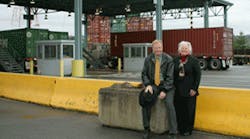The role trucking plays at U.S. ports is getting more attention this year in the wake of record freight congestion at major West Coast gateways, such as at the Ports of Long Beach and Los Angeles.
“The West Coast ports, principally Los Angeles/Long Beach, continue to struggle with unprecedented container volume surges,” said Charles Ogle, director of ocean buying & pricing, DHL Danzas Air & Ocean in Seattle, WA. Freight volume before the holiday season began “was well above forecasted levels, with Long Beach up 23% and LA up 10% over prior year, with Oakland and Seattle up about 10%,” he added.
“While the port industry is adding new labor to the work force as fast as they can hire and train new workers, this does not happen overnight,” Ogle said. “Trucking and rail services are similarly impacted and we expect this condition will last well into the fourth quarter before any significant relief is felt by users. Shippers would do well to try and design an additional seven days into their supply chains to allow for this.”
“Trucks are involved in every freight move somehow, for some goods they are moved land side 100% by truck whereas with intermodal rail moves there may be truck drayage to the railhead,” Jeannie Beckett, senior director-inland transportation, for the Port of Tacoma, WA, told Fleet Owner. “The question we deal with is what size truck is involved in transporting cargo, not whether a truck is involved or not.”
Approximately 70% of the cargo moved through the Port of Tacoma goes by rail, moving largely into the Midwest and beyond. The remaining 30% is handled exclusively by truck, but it’s a segment of the port’s transportation network that is getting a lot more attention, Mike Zachary, director of planning & logistics for Tacoma’s port, told Fleet Owner.
“Trucks are absolutely critical to our operations,” he said. “Yes, we primarily move most of our cargo out by rail, but trucks are instrumental in getting that freight to the rail head. They are a major component in that transportation chain.”
It’s a component that is dealing with far more volume, too. A major gateway to Asia and Alaska, the Port of Tacoma is the largest container port in the Pacific Northwest, handling 1.74 million TEUs (20-ft. container units) in 2003, along automobiles and bulk cargoes. However, the congestion at the ports of Los Angeles and Long Beach alone shifted 100,000 to 200,000 additional TEUs into Tacoma, said Zachary.
For that reason and others, Tacoma is trying to ease the movement of trucks into and out of its facilities via several road improvement projects initiated as part of a $341 million capital improvement plan green lighted in 2002.
“For example, we’re trying to enhance the ‘last mile’ trucks have to go to connect ocean containers with our intermodal rail yards and vice versa,” Zachary said. “We’re looking at dedicated lanes for trucks to help improve both safety and freight fluidity. We’re treating trucks with a lot of respect because they are critical partners to us – they are very, very valuable links in the supply chain.”
“I believe there are ways to make the pickup and delivery of cargo by truck more efficient for all,” added Beckett. “I think the ability to match cargo to truckers faster, whether through improved technology or better information on the status and location of loads, and the ability to pre-plan workflows so that cargo is mounted or at least placed in the appropriate pickup area can reduce delays.”
She feels most of the delays experienced by port truckers can eventually be reduced through information sharing and greater road capacity.
“That way, the cargo and equipment needed to move the equipment can be matched before the trucker arrives and the cargo can be ready for the pickup,” Beckett says. “Our industry has to start sharing more information between logistics providers if we are going to improve the efficiency and reliability of the whole logistics chain.”




